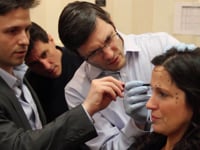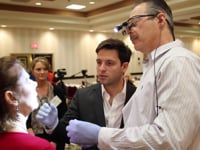What is Botulinum Toxin?
Botox® is a trade name for botulinum toxin, which comes in the form of a purified protein. The mechanism of action for botulinum toxin is really quite simple. botulinum toxin is injected into the facial muscles but really doesn’t affect the muscle at all. Botulinum toxin affects and blocks the transmitters between the motor nerves that innervate the muscle. There is no loss of sensory feeling in the muscles. Once the motor nerve endings are interrupted, the muscle cannot contract. botulinum toxin is a muscle relaxer. When that muscle does not contract, the dynamic motion that causes wrinkles in the skin will stop. The skin then starts to smooth out, and in approximately three to ten days after treatment, the skin above those muscles becomes nice and smooth. The effects of botulinum toxin last for approximately three to four months, at which time the patient needs retreatment. The areas that botulinum toxin is commonly used for smoothing of facial wrinkles are the forehead, between the eyes (glabellar region), and around the corners of the eyes (crow’s feet) and around the lips. botulinum toxin has important clinical uses as an adjunct in TMJ and bruxism cases, and for patients with chronic TMJ and facial pain. Botulinum toxin is also used to complement esthetic dentistry cases, as a minimally invasive alternative to surgically treating high lip line cases, denture patients who have trouble adjusting to new dentures, lip augmentation, and has uses in orthodontic cases where retraining of the facial muscles is necessary.
What are Dermal Fillers?
Dermal fillers will volumize creases and folds in the face in areas that have lost fat and collagen as we age. After age 30, we all lose approximately 1% of hyaluronic acid from our bodies. Hyaluronic acid is the natural filler substance in your body. The face starts to lack volume and appears aged with deeper nasolabial folds, unaesthetic marionette lines, a deeper mentalis fold, the lips start to thin, and turning down the corners of the lips. Hyaluronic acid fillers such as Restylane and Juvederm® are then injected extraorally right underneath these folds to replace the volume lost which creates a younger look in the face. Dermal fillers can be used for high lip line cases, asymmetrical lips around the mouth, lip augmentation, and completing cosmetic dentistry cases by creating a beautiful, young-looking frame around the teeth. The effect of dermal fillers typically last anywhere from 6 to 12 months at which point the procedure needs to be repeated. Both botulinum toxin and dermal fillers are procedures that take anywhere from 5 to 15 minutes. There is one huge advantage dentists have in delivering dermal fillers over any other healthcare professional. Most physicians and nurses use topical anesthetics and ice on the skin to numb the patient. Some actually learn how to give dental anesthesia but very few are proficient at it. As you may imagine, this will be a painful procedure when done this way. Indeed, this is the reason that many patients prefer dentists to deliver dermal fillers.
Will my malpractice insurance cover these procedures?
Malpractice issues are extremely rare for botulinum toxin and dermal filler cases. That being said, all healthcare professionals should have malpractice insurance that covers all the procedures they perform. Some dental liability insurances are now offering riders for these treatments. Some dental liability insurance companies are not now set up to cover dentists for botulinum toxin and dermal filler procedures but this is rapidly changing. Every dentist should check with their own insurance provider and see what their status is. If your insurance carrier is not set up now to provide this coverage, there are third party add-on malpractice liability insurance carriers that will cover dentists who have been properly trained for these procedures and we work with a few through our training courses. These policies will be in addition to the malpractice insurance you already have and are very reasonably priced. We discuss all of the options at our courses and can help you decide which option is best for you. We have worked with and written the protocols for some of the major dental liability insurance companies and our course is accepted by them as outstanding training in these procedures. IMPORTANT NOTE: Many dentists call their current malpractice insurance agents and ask if the dentist is covered by their plan. Some of the insurance agents tell the dentists that it is illegal for them to place Botox® and dermal fillers or other misinformation. What they are trying to do is keep you from switching insurance plans and losing your business. Your liability insurance agent is not in the position to tell you what you should and should not be doing and is not a reliable source when it comes to this area. The additional liability insurance will be in addition to your current liability insurance - your insurance agent will not lose any business if you are performing Botox® and dermal fillers.
Does my state dental board allow dentists to perform Botulinum toxin and dermal filler procedures?
Most dentists are surprised to learn that most of the states and provinces in the US and Canada allow general dentists to perform both botulinum toxins and dermal fillers in the oral and maxillofacial areas WITH PROPER TRAINING. There is no question that the tide is certainly turning rapidly for this to be accepted nationwide with more state dental boards allowing these procedures. Many states respond that they don't regulate individual procedures just as they don't regulate implant, esthetic, or prosthodontic procedures and if a dentist is properly trained and competent, they leave it to the dentist's discretion. It is certainly appropriate for dentists to use botulinum toxins and dermal fillers for dental uses within the scope of dentistry as defined by your state practice act which most of the time includes but is not limited to treatment of the masseter, temporalis, frontalis, corrugator, procerus, obicularis oris for TMJ and facial pain cases, oral and maxillofacial areas, lip augmentations, and treatment in the lower face. Any areas that a dentist already can treat in the oral and maxillofacial regions, take a biopsy from, and/or inject with local anesthetic would be included in areas that may be treated with botulinum toxin and dermal fillers. Please note - this is not a legal opinion and is based on our numerous conversations with state dental boards. Feel free to contact us about the information we have about your state dental board.
Where can a dentist get training for Botox® and dermal fillers?
You have come to the right place - to sign up please see below or go to www.facialesthetics.org . to sign up today. Training is the key to developing the skill to performing this exciting treatment for patients and to satisfy your dental state board and third party liability insurance requirements. We have trained thousands of dental and healthcare professionals in botulinum toxin and dermal filler therapy. There is a very short learning curve because dentists are already well trained in injections. What you need to learn is competency in understanding the mechanisms of these materials, reviewing the facial expression muscles, indications, risks and benefits of these treatments, and hands on training in placing these materials and preventing and managing complications. With some practice, you can be well on your way to performing these procedures. Many state dental boards allow dentists to deliver these esthetic facial injectable therapies so check with your own state board.
How is your training different?
We offer the most hands-on training of just about any other botulinum toxin and dermal filler course available for healthcare professionals. You will be prepared after you leave this course to begin treating patients as soon as you get back to your office. We teach about many of the available products and participants are encouraged to use a few different products in the hands-on section of the course. Our training courses do not limit you to one specific dermal filler product. We use real botulinum toxins and dermal fillers in our hands-on live patient workshop for patient treatment. We do not limit you to using a small amount of botulinum toxin like other courses. Use as much as needed to achieve the desired treatment results so you get optimal experience in botulinum toxin therapy. Other medical training courses have you use saline or placebo fillers to inject into patients which is essentially useless. For an optimal learning experience, we have you use your own patients that you can then evaluate a week later and see with your own eyes how to achieve total facial esthetics. If you use a patient you will never see again, how do you know and learn if your treatment has been effective? This is the best way to learn these skills. We have consulted and created protocols for malpractice liability insurance carriers. Our course is accepted by malpractice insurance carriers. We teach how to incorporate botulinum toxins and dermal fillers into your general dental and esthetic dental case treatment plans - taking a medical course on esthetics will completely ignore these issues which are vital to your dental practice. Dental uses for botulinum toxins and dermal fillers include TMJ and bruxism cases, denture cases, treating high lip lines, uneven smile lines, lip augmentation, developing an ideal occlusion, and smoothing of facial wrinkles - all of this only taught at our course. The medical training courses also spend a lot of time on areas that the dentist will never be able to treat so you will waste significant time and money at those courses. We train dentists in the real dental uses for botulinum toxins and dermal fillers in addition to the smoothing of facial wrinkles and folds. This is very important for dentists because you need to be able to use these procedures in your practice within the scope of dentistry as defined by your state dental board. Participants are able to bring and fully treat patients and are not limited to just using a little bit of botulinum toxin or dermal fillers like other courses. What usually happens is the dentists get even more experience as many times the participants want to be a patient for some botulinum toxins and dermal fillers. We have a 98% excellent evaluation rating from our attendees - among the highest in the dental or medical education industry.
I have taken other Botulinum Toxins and Dermal Fillers Courses Can I Take the Advanced Level II Course?
Our level I botulinum toxin and Dermal Filler training course is the most comprehensive training course available. What you have learned at other courses might not make you ready for our advanced level II course.
What is the future of Botulinum toxin and dermal fillers in dentistry?
There are currently approximately 17% (and growing fast) of dentists who perform botulinum toxins and dermal fillers in North America. Botulinum toxins and dermal fillers will grow much faster than other areas of dentistry that require large equipment purchases. There is no large investment that needs to be made by dentists other than the products you are going to deliver which is another reason it is so popular. The only investment is in training to become proficient at delivering botulinum toxins and dermal fillers.
Why are Botulinum toxins and dermal fillers becoming so popular with dentists now?
First of all, many state boards now allow dentists to perform these procedures. Secondly, dentists are realizing that their knowledge of the facial structures and certainly the lower half of the face far exceeds most other healthcare providers including most plastic surgeons, dermatologists, physicians, nurses, physicians assistants, and medical aestheticians, all who can now place botulinum toxins and dermal fillers. Thirdly, dentists are among the best injectors in any healthcare industry. Finally, with training, dentists have the artistic creativity and clinical skills necessary to have very successful outcomes for their patients. Most dentists have not realized how popular these treatments are with their patients or their families. Here is a true story that happened recently at one of our courses – a dentist brought his wife as the model patient for the Botox and dermal filler course. In the conversation with the wife, she mentioned that she spent $1500 at the dermatologist office every 3 months on botulinum toxins and the dentist (her husband) had no idea that she had been doing this for 2 1/2 years! He and she were very pleased they would be saving literally thousands of dollars a year now by the dentist himself performing these treatments on his wife. She even asked me how much the course is and when I told her, she tells all the dentists watching "You are going to get your money back so fast on this course!" She couldn't have given a better testimonial. An even better testimonial happened after the course. They called us a week later and reported she had a better result than she ever had at the dermatologist's office! We gave her post op instructions and exercises to do that they never told her about at the other office. We as dentists are among the best healthcare provider to be delivering these treatments on patients.
Here are some tips for choosing a model patient for the Botulinum toxin training course:
The facial areas that are ideal to treat with botulinum toxin are the forehead lines when the patient makes a “surprised” look, the frown lines between the eyes when the patient makes the “mad” facial expression, and the “crow’s feet” lines at the corner of the eyes. The model patient should have light to moderate lines – these are the best patients to train on. If your patient has TMJ and/or bruxism, these areas will be addressed as well. Patients must be in good health with no active skin infections in the areas to be treated. Patients with neurological, autoimmune and immunological diseases are not the best candidates as well as people with long term systemic diseases. The patient should by healthy and have a clean medical history. Patients who bruise easily because of medications or other disease processes may not be good candidates. The model patient should not be needle phobic. Patient must be in good health with no active skin infections in the areas to be treated. Patients with autoimmune and immunological diseases are not the best candidates as well as people with long-term systemic diseases. The model patient should not have any important life events coming up within two weeks of treatment. The model patient may have some swelling and bruising after treatment. Every model patient must sign an informed consent prior to treatment and there will be no exceptions. We reserve the right to refuse treatment to any patient. If you have any questions about your patient, please email Dr. Malcmacher [email protected].
Here are some tips for choosing a model patient for the dermal filler course:
The facial areas that are ideal to treat with dermal fillers are the nasolabial folds (lines from the corner of the mouth to the corner of the nose), marionette lines (lines from the corner of the lips that go down the face toward the jaw line), and uplifting the corners of the lips. Lip augmentation may also be done on a patient that would like to enhance the fullness of their lips. The model patient should have light to moderate lines – these are the best patients to train on. The model patient should not be needle phobic. The model patient should be easy to anesthetize and be able to tolerate local dental anesthesia. Patients must be in good health with no active skin infections in the areas to be treated. Patients with neurological, autoimmune and immunological diseases are not the best candidates as well as people with long term systemic diseases. The patient should by healthy and have a clean medical history. Patients who bruise easily because of medications or other disease processes may not be good candidates. The model patient should not have any important life events coming up within two weeks of treatment. The model patient may have some bruising after treatment. Every model patient must sign an informed consent prior to treatment and there will be no exceptions. We reserve the right to refuse treatment to any patient. If you have any questions about your patient, please email Dr. Malcmacher at [email protected]
How many continuing education credits are available for this course?
Each Level I course day will give the attendees a full 10 AGD PACE/ADA CERP continuing education credits which is the required amount for liability insurance purposes.
What is the deadline for registration?
Classes are filled on a first-come, first served basis. Most classes fill up well in advance as the class size is limited so every attendee gets plenty of one on one instruction. Sign up today for training on botulinum toxins and dermal fillers in every dental practice. We hope to see you at a course very soon.


